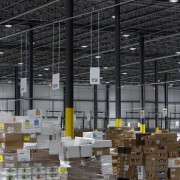Transportation Management Systems: 5 Shipper Demands Shaping the TMS Landscape
Characterized as one of the fastest growing enterprise application markets by ARC Advisory Group, the transportation management systems (TMS) sector has been growing at a double-digit rate over the last couple of years—and isn't showing signs of letting up anytime soon.
A technology solution that helps companies efficiently, reliably, and cost effectively move freight from origin to destination, most transportation management systems includes both planning and execution solutions (systems for freight moves involving carriers). Shippers are embracing transportation management systems, according to ARC analysts, thanks mainly to the strong ROI offered up by such solutions.
“The simple, bottom line is that TMS can save companies money by lowering their freight spend,” says Steve Banker, ARC’s service director of supply chain management.
Banker points to an ARC survey as proof of that point, adding that over 40 percent of respondents felt that if they were forced to give up their TMS and go back to more manual processes for planning and execution, their total freight costs would increase by 5 percent to 10 percent. “In fact, 23 percent felt their total freight costs under the control of the TMS would increase by over 10 percent if they were to stop using it,” he adds.
For logistics professionals charged with the movement of freight, transportation management systems can also help create transportation efficiency, provide real-time dashboards, enable better decision making, and handle myriad other tasks that can’t be adequately addressed with phones, faxes, and spreadsheets.
5 Shipper Demands Shaping Transportation Management Systems
Here are the 5 shipper demands that supply chain software analysts say are shaping the TMS landscape—and pushing even more logistics professionals to put it to work.
1. The omni-channel retailer needs support
 No longer able to compartmentalize their various business channels, today’s retailers and industrial suppliers need help running seamless, omni-channel systems that incorporate bricks-and-mortar, online, mobile, catalogue, and other sales channels under a single umbrella.
No longer able to compartmentalize their various business channels, today’s retailers and industrial suppliers need help running seamless, omni-channel systems that incorporate bricks-and-mortar, online, mobile, catalogue, and other sales channels under a single umbrella.
Transportation plays a key role in this streamlining, which means transportation management systems also play an important part in creating the omni-channel environment. For example, with the B2C sector gaining much maturity in the world of online/eCommerce fulfillment, more and more distributors and industrial suppliers are putting catalogs online and offering seamless eCommerce freight shipping calculations to their customers, because now the shipping quotes include real freight rates, such as LTL and small package, because the shopping cart integrates into transportation management systems.
2. Transportation Management Systems Mirroring Trends such as Near-Shoring and Reshoring
Undoubtedly you have heard of the biggest trend shaping US Manufacturing at present: Near-shoring and Reshoring. If you want to know more about this trend, make sure you read our reshoring series here. However, as companies are now moving manufacturing facilities back to the US, and as companies in the automotive industry are moving facilities near the US to places like Mexico, we are seeing an increase in volumes of freight. As in any economic force, when there is greater demand for capacity, the prices are going up. To combat rising prices due to economic forces, logistics managers are going to have a competitive edge if their transportation management systems can handle shipments in all of North America, with all American, Mexican, and Canadian facilities having visibility to all shipments under one user control. This visibility allows for good information flows, giving access to data, which allows for better business decisions when making future business decisions involving transportation.
3. Embedded analytics are in high demand
Bombarded daily by terabytes of digital information, shippers need a way to wade through the data, select its most useful components, and then use that information to make the best possible transportation decisions.
Transportation management systems that effectively embed analytics, help to discover rich and meaningful patterns within the data, will remain in high demand. A TMS that includes carrier score-carding, for example, should be able to cross-pollinate that rating information for application during the vendor-selection process. Embedded analytics allow shippers to come up with useful key performance indicators and actually consume and utilize the data as they go about their other activities.
4. Shippers Want Transportation Management Systems that help them utilize Backhauls and Support Services for Reverse Logistics
Retailers and those in the automotive aftermarket industry are particularly interested in not hauling empty trucks back to their DCs after the goods have been delivered, says Rishi Raina, principal of North American supply chain technologies at Capgemini. “They want to be able to utilize their networks more efficiently, and they’re looking to their transportation management systems for help in this area,” Raina adds.
And while some of the more established vendors have historically incorporated back haul capabilities into their platforms, the challenge lies in setting up more of a robust reverse logistics program: tying carrier contracts, agreements, and negotiations into the equation. “If a shipper can get through those hurdles, there will be a lot of savings to be unlocked on the backend,” says Raina.
5. Planning, Execution (Read: Integration) could get a place at the TMS table
Right now, transportation management systems vendors are looking for ways to better tie planning and execution systems into their platforms. “Traditionally, those systems have operated within their own silos, and with no tie-in to transportation,” Raina points out.
Many transportation management systems providers are beginning to integrate those processes in a way that will allow shippers to more efficiently monitor manufacturing and production cycles as part of the distribution process. “There has to be a better way of managing the flow and synchronization among transportation, planning, and execution,” says Raina. “In fact, there’s a huge amount of interest in this from the shippers’ perspective right now, but none of the TMS platforms are fully there yet.”
Other Transportation Management Systems Trends
Other trends unfolding in the TMS space include the continued interest in cloud-based solutions that require low upfront fees and minimal IT infrastructure; an ongoing push to upgrade older systems and replace them with state-of-the-art platforms; and the need for holistic TMS that can do more than just track transportation movement and spend. Raina adds that the latter will likely help drive TMS growth and innovation well into 2014.
Third-party logistics providers are especially interested, for example, in adopting end-to-end, holistic TMS that can handle optimization, dedicated fleet management tasks such as driver invoicing and payroll, and traditional brokerage operations.
“There hasn’t been a strong case for a TMS that can do all three of these things well,” adds Raina, “so it’s an area that software vendors are examining more closely based on the market demand that we’re seeing for it.”
March 10, 2014
Retrieved from:
http://cerasis.com/2014/03/10/transportation-management-systems/







